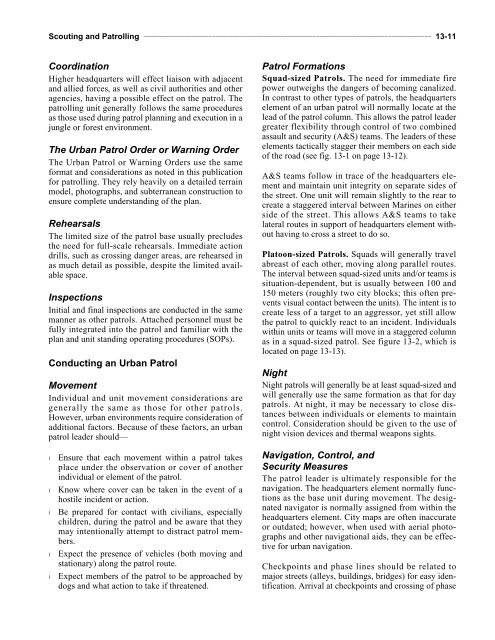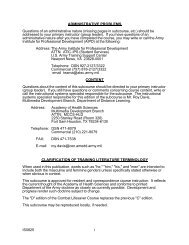MCWP-3-11.3-Scouting-and-Patrolling
MCWP-3-11.3-Scouting-and-Patrolling
MCWP-3-11.3-Scouting-and-Patrolling
You also want an ePaper? Increase the reach of your titles
YUMPU automatically turns print PDFs into web optimized ePapers that Google loves.
<strong>Scouting</strong> <strong>and</strong> <strong>Patrolling</strong> ________________________________________________________________________________ 13-11CoordinationHigher headquarters will effect liaison with adjacent<strong>and</strong> allied forces, as well as civil authorities <strong>and</strong> otheragencies, having a possible effect on the patrol. Thepatrolling unit generally follows the same proceduresas those used during patrol planning <strong>and</strong> execution in ajungle or forest environment.The Urban Patrol Order or Warning OrderThe Urban Patrol or Warning Orders use the sameformat <strong>and</strong> considerations as noted in this publicationfor patrolling. They rely heavily on a detailed terrainmodel, photographs, <strong>and</strong> subterranean construction toensure complete underst<strong>and</strong>ing of the plan.RehearsalsThe limited size of the patrol base usually precludesthe need for full-scale rehearsals. Immediate actiondrills, such as crossing danger areas, are rehearsed inas much detail as possible, despite the limited availablespace.InspectionsInitial <strong>and</strong> final inspections are conducted in the samemanner as other patrols. Attached personnel must befully integrated into the patrol <strong>and</strong> familiar with theplan <strong>and</strong> unit st<strong>and</strong>ing operating procedures (SOPs).Conducting an Urban PatrolMovementIndividual <strong>and</strong> unit movement considerations aregenerally the same as those for other patrols.However, urban environments require consideration ofadditional factors. Because of these factors, an urbanpatrol leader should—l Ensure that each movement within a patrol takesplace under the observation or cover of anotherindividual or element of the patrol.l Know where cover can be taken in the event of ahostile incident or action.l Be prepared for contact with civilians, especiallychildren, during the patrol <strong>and</strong> be aware that theymay intentionally attempt to distract patrol members.l Expect the presence of vehicles (both moving <strong>and</strong>stationary) along the patrol route.l Expect members of the patrol to be approached bydogs <strong>and</strong> what action to take if threatened.Patrol FormationsSquad-sized Patrols. The need for immediate firepower outweighs the dangers of becoming canalized.In contrast to other types of patrols, the headquarterselement of an urban patrol will normally locate at thelead of the patrol column. This allows the patrol leadergreater flexibility through control of two combinedassault <strong>and</strong> security (A&S) teams. The leaders of theseelements tactically stagger their members on each sideof the road (see fig. 13-1 on page 13-12).A&S teams follow in trace of the headquarters element<strong>and</strong> maintain unit integrity on separate sides ofthe street. One unit will remain slightly to the rear tocreate a staggered interval between Marines on eitherside of the street. This allows A&S teams to takelateral routes in support of headquarters element withouthaving to cross a street to do so.Platoon-sized Patrols. Squads will generally travelabreast of each other, moving along parallel routes.The interval between squad-sized units <strong>and</strong>/or teams issituation-dependent, but is usually between 100 <strong>and</strong>150 meters (roughly two city blocks; this often preventsvisual contact between the units). The intent is tocreate less of a target to an aggressor, yet still allowthe patrol to quickly react to an incident. Individualswithin units or teams will move in a staggered columnas in a squad-sized patrol. See figure 13-2, which islocated on page 13-13).NightNight patrols will generally be at least squad-sized <strong>and</strong>will generally use the same formation as that for daypatrols. At night, it may be necessary to close distancesbetween individuals or elements to maintaincontrol. Consideration should be given to the use ofnight vision devices <strong>and</strong> thermal weapons sights.Navigation, Control, <strong>and</strong>Security MeasuresThe patrol leader is ultimately responsible for thenavigation. The headquarters element normally functionsas the base unit during movement. The designatednavigator is normally assigned from within theheadquarters element. City maps are often inaccurateor outdated; however, when used with aerial photographs<strong>and</strong> other navigational aids, they can be effectivefor urban navigation.Checkpoints <strong>and</strong> phase lines should be related tomajor streets (alleys, buildings, bridges) for easy identification.Arrival at checkpoints <strong>and</strong> crossing of phase



